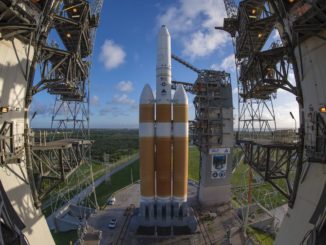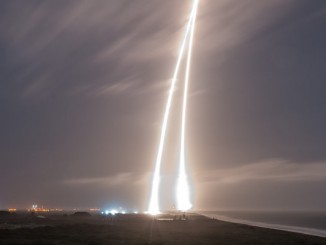EDITOR’S NOTE: Updated at 4 p.m. EST (2100 GMT) with details on the aircraft.
Launch was aborted for 7:37am ET today due to an aircraft in the launch zone. Watch: https://t.co/mzKW5uDsTi pic.twitter.com/ltpdPInYtL
— NASA (@NASA) November 11, 2017
Managers aborted liftoff of a commercial Antares cargo launcher Saturday when an aircraft strayed into restricted airspace near the rocket’s planned flight path east from Virginia’s Eastern Shore.
The Antares rocket and a Cygnus supply ship, both owned by Orbital ATK, were ready for liftoff at 7:37 a.m. EST (1237 GMT) Saturday. The launch team loaded kerosene and liquid oxygen propellants into the first stage of the Antares booster, and a computer-controlled countdown sequencer took over for the final three minutes before liftoff.
But an unidentified aircraft ventured into the safety zone surrounding the rocket and its planned trajectory over the Atlantic Ocean. Officials said after the scrubbed launch attempt that it was a small airplane that flew a few miles northeast of the pad at low altitude, and not a commercial jetliner.
“LC, LC, we are red,” a member of the launch team told Adam Lewis, Orbital ATK’s launch conductor. “We have an aircraft in the hazard area.”
“Copy that,” Lewis replied. “Abort, abort, abort. This is LC on the countdown net. Abort, abort, abort. Proceed to the abort safing checklist.”
The Antares rocket had five minutes to take off Saturday and still send the Cygnus supply ship on a path to intercept the International Space Station and deliver 3.7 tons of cargo, provisions and experiments to the lab’s six-person crew.
There was no time to wait for the aircraft to clear the the safety box, and managers ordered a scrub.
Another launch attempt is set for 7:14 a.m. EST (1214 GMT) Sunday from pad 0A at the Mid-Atlantic Regional Spaceport at NASA’s Wallops Flight Facility on Virginia’s Eastern Shore.
Despite freezing temperatures in the upper 20s Fahrenheit, weather was not a problem during Saturday’s countdown. Mostly clear skies and light winds will continue to be in the forecast Sunday, and there is a 90 percent chance weather will be acceptable and within the Antares rocket’s constraints.
Orbital ATK’s launch team planned to drain propellants from the Antares first stage later Saturday morning, then prepare to return to the launch control center just after midnight Sunday to begin the countdown anew.
Authorities publish notices to pilots and mariners to keep them away from rocket drop zones and safety corridors, but the warnings sometimes go unheeded, prompting launch delays.
The Antares launch operates under a commercial license issued by Federal Aviation Administration, which oversees the flight to ensure public safety.
With Saturday’s scrub, the Cygnus supply ship’s arrival at the space station will move back one day until Tuesday.
Astronaut Paolo Nespoli will capture the automated cargo craft with the station’s robotic arm around 4:45 a.m. EST (0945 GMT) Tuesday, around the same time a United Launch Alliance Delta 2 rocket is set to lift off from Vandenberg Air Force Base in California on an unrelated mission to loft a NOAA weather satellite into orbit.
The Delta 2 launch is set for 4:47 a.m. EST (0947 GMT; 1:47 a.m. PST) Tuesday.
Email the author.
Follow Stephen Clark on Twitter: @StephenClark1.



